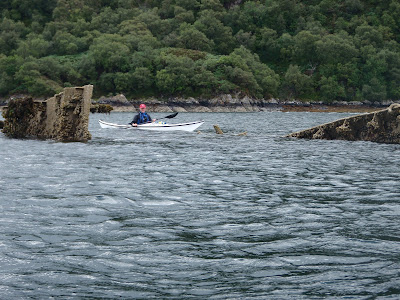Monday, 10 October 2011
A wreck and a life less ordinary
As we paddled towards Kyleakin, the first point of interest we came to was the wreck of HMS Port Napier. A 9600 ton merchantman, Port Napier had been converted to a minelayer by the Admiralty and was loaded with 550 mines when she began dragging her anchor in a gale on 26 November 1940. As was common practice, the detonators for most of the mines had been inserted whilst at anchor as it was such a difficult task at sea with the ship pitching and rolling.
To make matters worse, fire broke out in the ships machinery spaces and there was a realisation that if the mines detonated the resulting explosion would probably flatten most of Kyle of Lochalsh and Kyleakin. The ship was towed well out into Loch Alsh and with incredible bravery a party of sailors returned onboard and began removing detonators from the mines and deploying them down the chutes to get them clear of the ship. With the fire worsening, the crew abandoned the ship and retreated.
Some time later there was a huge explosion from the engine room which fortunately didn't detonate the mines. It was big enough to blow out a huge section of the starboard side of the ship and send the superstructure up into the air, it landed on the shore nearby. The ship rolled onto her starboard side and sank quickly in 20 metres of water. The remaining mines were removed later and today the Port Napier is a popular dive site.
Our next stop was a place I've wanted to visit for a long time. On the Skye shore, blending into the landscape is the house built by Tom Leppard, otherwise known as the "Leopard Man". Tom moved here in 1987 and spent three years building a home constructed entirely of drystone and items beachcombed from the shore. The media became fixated with his appearance - understandably since he is tattooed in leopard markings from head to foot (he was in the Guiness Book of Records as the world's most tattooed man), and described him as a recluse who shunned human contact. This isn't really the case though as Tom used a kayak to cross to Kyle each to draw his pension (he is an ex-military man), to do his shopping at the Co-Op and to have a beer.
His lifestyle was certainly unconventional, but he was no survivalist hermit. The house seems to grow organically from the spit of land he chose, there are gravelled paths, trees planted and nurtured in just the right way, stone retaining walls, a hollow made parallel to a stream bed to serve as a bath. And decoration too, natural and pleasing. Tom spent much of his pension money on bird food and had feeding stations all around his house. I've been told that many of the birds were hand tame and that the deer didn't seem to see him as a threat.
The interior of the house is tight and compact but very functional. An obvious amount of care and thought went into making it as comfortable as possible.
Storage areas are made from wooden boxes and built flush into the drystone walls. The floor has drainage channels to allow any rain water to escape.
Tom Leppard left his house in 2008 after nearly 20 years of living close to the land. He was 73 and had begun to find crossing the Kyle an increasing challenge. He still lives in Skye, in a retirement home in Broadford. His possessions are largely still here though.
The Leopard Man's House deserves to be kept in good condition - sadly it's seen some abuse recently. If you visit, pull a few weeds from Tom's beautifully winding gravel paths, or take some rubbish away with you.
Tom Leppard "The Leopard Man of Skye" has lived a life less ordinary; the world is all the richer for folk like him
Labels:
history,
Kyle of Lochalsh,
sea kayaking,
Skye,
Wrecks
Subscribe to:
Post Comments (Atom)





Ah! A Walker's fish box! If only they were still washed up instead of those awful plastic crates! Fires, seats, tables......
ReplyDeleteNow thats a paddle! Thanks for sharing the story of the leopard man home (looks awesome)and HMS Port Napier. Fantastic stuff no other kayakers one would hear of if not for posts like this.
ReplyDeleteThanks again really enjoyed that.
Hi Vince,
ReplyDeleteYep, plastic fish boxes aren't my idea of progress! Tom had used several boxes as shelving, furniture and cladding
Thanks Lee,
It's nice to find (or in this case, be shown) unusual sights and places, then to research a bit more about them. I guess that's a good part of why I blog!
Kind Regards